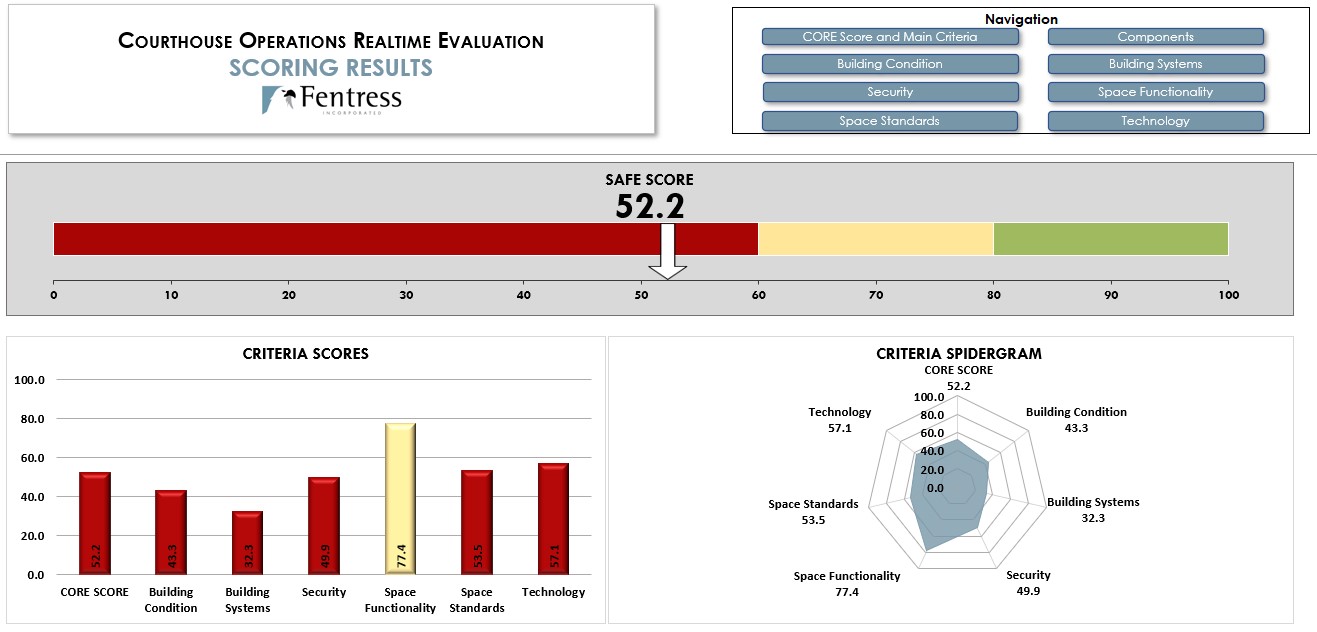We perform assessments to determine if the space in a courthouse supports the administration of justice. This is not a facility condition assessment that looks at building systems. Our assessments examine how well a courthouse functions, whether it is secured, and if it meets acceptable design standards. To do this, we maintain a library of over 500 courthouse performance metrics which can be used to identify deficiencies in an individual courthouse or a portfolio of courthouses.
How do I know if my courthouse is meeting the operational needs of the court? What problem areas could benefit the most from a renovation? How does my courthouse stack up against others? If you find yourself asking these questions… you’ve come to the right place!
I am a statistical data analyst who has scored hundreds of courthouses using metrics over the course of my career, so I know a thing or two about performance metrics.
Assessing courthouses comes down to three main goals: quantifiable assessments, identifiable deficiencies, and comparable results.
Quantifiable Assessments
Personal biases have no place in a courthouse assessment. Performance metrics provide an objective way to evaluate how well a courthouse supports the court’s operations. They rely on concrete data rather than opinions or perceptions and remove the subjectivity associated with individual judgments.
Courthouse assessments should capture data on five criteria: building condition, space functionality, space standards, security, and technology.
- Building Condition – The condition of the general building and judiciary tenant space of the facility, including the general condition of the court spaces, common areas, lobbies, elevators and stairways, and exterior spaces on the site (e.g., plaza, walkways, and parking)
- Space Functionality – The extent to which space supports the number and operations of judges and staff and functions properly for adjacencies, layout, accessibility, and circulation
- Space Standards – The conformance of space with the jurisdiction’s applicable standards for size, quantity, and proportion; best practices are used if standards are not available
- Security – The security features in the facility, such as public, restricted, and secure circulation patterns, prisoner holding areas, sallyports, and courtroom holding cells
- Technology – The availability of technology systems in the courthouse to support court proceedings, public access, and coordination between court components
With multiple factors and clear performance measures for each factor, court planners and architects are able to walk through a courthouse and determine a quantifiable score for each criterion as well as the courthouse as a whole.
Identifiable Deficiencies
By using performance metrics, courthouse administrators can identify specific areas that require improvement. Metrics help pinpoint weaknesses, allowing targeted efforts for enhancement. Scores range from 0 - 100, with 100 representing an ideal courthouse, 80 - 100 representing a well-functioning courthouse, and a score below 60 representing a courthouse with significant challenges.
The image below presents a dashboard of a courthouse that scored in the “poor” range. Space functionality scores the highest (yellow bar) but all other criteria score below 60 (red bars). This analysis helped to justify the need and funding for a new courthouse.

Sample of courthouse performance metrics dashboard
Examining the scores for a courthouse allows you to determine the magnitude of deficiencies with each criterion. For example, if your courthouse scores an 85 in space functionality, but only scores a 45 in security, that means attention needs to be paid to the security of the courthouse.
Looking at an even more granular level, the individual security factors will identify what specific security features are missing or need improvement. For example, is there secure circulation where required?
Going one step further, the same performance metrics can be used to score possible solutions to the identified problem areas. If Solution A brings the security score up from 45 to 76 while Solution B brings the security score up to 83, Solution B would be the most beneficial solution (excluding any cost-benefit analysis, which we can tackle in a future blog).
Comparable Results
Performance metrics provide a standardized framework for evaluating courthouses, ensuring that all courthouses are assessed using the same criteria. This consistency allows for fair and meaningful comparisons between different courthouses. In other words, courthouses, as well as courthouse projects, can be compared on an “apples to apples” basis, which is extremely helpful when trying to prioritize across a portfolio.
As an example, we worked on a court campus with multiple buildings. It was not only important for the court to understand the space needs of each building, but they also wanted to spread out their funding in an equitable fashion. Using performance metrics, we examined the notion of equity between buildings and between court and related components.
This analysis helped the county spread the funds in a manner that benefited all of the components. Using the performance metrics, we could show how many points could be gained in each facility for the available funds. This helped to optimize space across the campus.
Final Thoughts
Performance metrics can help your assessments go from subjective to objective. If you want to know how well your courthouse is operating from a fair and unbiased standpoint, if you want to know what areas of your courthouse need the most improvement, or if you simply want to know how your courthouse conditions compare to other courthouses… performance metrics are the answer you’ve been looking for!



.jpg)

.jpg)
.jpg)
.jpg)
.jpg)
.jpg)
.jpg)


-1.jpg)
.jpg)
.jpg)

